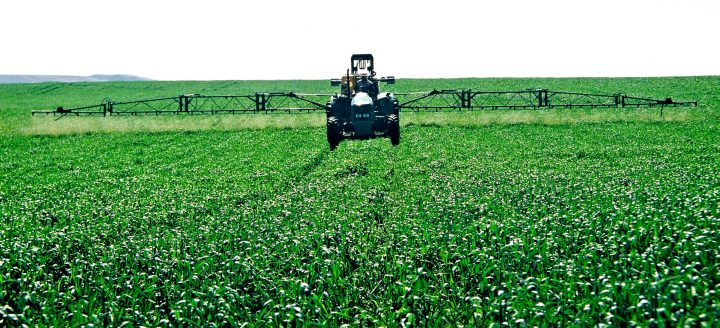#UnPoisonOurAir Webinar
Toxic spray drift: The invisible clouds that can cause severe illness

Most of our food is the product of chemical farming. Such farming practices have left communities suffering from the effects of ‘pesticide drift’ or ‘spray drift’.
The Agrichemical Working Group, which consists of members from the South African Organic Sector Association, Biowatch, The Air That I Breathe Foundation (Tatib), and several other organisations, has launched its #UnPoison webinar series to raise awareness on the impacts of agrochemicals.
The first webinar, titled #UnpoisonOurAir – Toxic Spray Drift, focused on people who have first-hand stories of exposure to the drifting of spray and dust from agrochemical (pesticides, herbicides, fungicides and fertilisers) applications.
Speakers included Jurgen Schirmacher, who lived in Riebeeck Kasteel where he and his family were poisoned by the spray drift from a nearby wine farm; Sasha ( Surname withheld on request GMO & Poison Free Zones); and farmworkers who told of illnesses and working with no protective equipment. The webinar is currently unavailable to the public to protect the identity of some of the speakers.
South Africa’s poison problem
The health and environmental issues associated with contamination caused by agrochemical farming in South Africa are largely undocumented and thus disregarded by regulatory authorities.
Most of our food is the product of chemical farming. Such farming practices have left communities suffering from the effects of “pesticide drift” or “spray drift”.
Thousands of people living close to farming areas in South Africa, where more than 3,000 pesticides are registered for use, report alarming symptoms. Numerous studies have linked pesticide exposure to endocrine damage, acute poisoning, immune disorders and respiratory disorders.
“We have a lack of adequate legal framework. We have got a very pious legal framework that assumes that the society is just going to be the mainstay of agricultural production,” says Sasha. She adds that “from the onset, we are set with this bias toward the notion that this is unavoidable in our food system” and that the agrochemical industry is ensuring that this remains the “status quo”.
“Rural communities affected by pesticide spray drift have little, if no, recourse to have the rights to clean air and clean water protected. We have images showing how the application of pesticides at times takes place in very close proximity to people’s homes [or] schools,” says Sasha.
Indirect exposure: stories of illness and legal battles
Schirmacher and his family lived in Riebeeck Kasteel where they were poisoned by the spray drift from a large wine farm in the area.
“We bought an old farmhouse in the mid-2000s. We wanted to move there because we thought that it would be fresh and clean and would be a wonderful place to start a family and raise children. We had our first child, and everything went well.”
However, things quickly changed when a grape farmer bought vacant land near Schirmacher’s house. His wife was pregnant with their second child at the time.
“During her pregnancy, he had commenced spraying those grapes,” says Schirmacher. The large clouds of pesticides (which can travel as far as 8km) flew through Schirmacher’s garden, on to their clothes and their vegetable patch and into their house.
“We approached him, and I said, ‘Look, I am concerned about the spray drift. My wife is pregnant, I don’t want anything to happen to her or the baby.’”
Unfortunately, the farmer was not willing to address Schirmacher’s concerns.
Five weeks after his son Christopher was born, the baby began exhibiting serious health problems. He was taken to a hospital where doctors took one look at him and had him admitted immediately. Later that day, Christopher went into cardiac and respiratory arrest.
It took 45 minutes for doctors to stabilise Christopher, but they told his family that he would not survive the night.
“He had brain seizures that first night, but he survived. The doctors ran some blood tests, and they all came to the conclusion that it was the exposure to what was being sprayed while my wife was pregnant that had had an effect on him in terms of his development.”
Schirmacher had demanded that the farmer tell him what pesticide spray was being used. The farmer had met the poison supplier and an attorney outside his property and, in essence, said to the supplier, “Make a list of everything we use, except for those of LD50 (lethal dose 50% — LD50 substance kills 50% of whatever organism the substance comes into contact),” says Schirmacher.
“I threatened him with a subpoena to the high court if he didn’t tell me [what this chemical was]. And it turned out that LD50 was the lethal dose to kill half the population that the pesticide was exposed to.”
Schirmacher adds that he gave the farmer several opportunities to meet and find an amicable solution before he took legal action.
The pesticides that were being used are categorised by the World Health Organisation as highly toxic.
Schirmacher’s fight against the farmer resulted in a ban on one of the chemicals. He has since immigrated to Australia, where he continues to fight against the dangers of spray drift. Schirmacher has a wealth of information, videos and stories on the topic on his website.
‘My whole body got inside out’
Ansune (surname withheld for privacy) lives in Stellenbosch with her children. She was in excellent health until 2007, when she began working near a strawberry farming area.
“My whole body got inside out and went from being completely healthy to having panic attacks and severe eczema, I think there was definitely some form of neurotoxin that was being sprayed at that time.”
Ansune says the school that her children attend is in a strawberry farming area.
“My concern is for my children and for my health,” says Ansune, who adds that she is also concerned for the safety of the farmworkers.
“I drive past [the strawberry farms] and I just think that there must be more to protect the people who actually work on the farm.”
Direct exposure: farmworkers are the most vulnerable
Henry, from the Surplus People Project, says there is a range of abuses and malpractices occurring on farms. The organisation intervenes in severe cases, such as the ones described below:
Nina (whose surname has been withheld) runs a forum that is dedicated to the rights of farmworkers.
“I live on a farm and have first-hand exposure to the pesticides. The farmers do not give the farmworkers any form of protective gear. They have no masks, no overalls. There have been many health problems, many lung problems, sinus, and asthma. When the spraying takes place, farmworkers are not moved aside, they spray while the farmworkers are still working on the land. That dust gets inhaled. This is very problematic; there is no safety on these farms.
“One of my friends also worked on a farm and every time before tomatoes were planted, certain pesticides are thrown onto the ground.”
One day, her friend was sitting on a tractor and had a bucket of powdered pesticide that she had to sprinkle on the ground. The bucket tipped over on to one of her legs and the poison burnt a hole in it. The farmer was reluctant to take her to the doctor and to this day she suffers from her injury.
Another woman, who has chosen to remain anonymous for her own safety, tells a harrowing story.
On the farm she was working on, the farmer would leave out soda bottles filled with water in the shed for the workers. She recalls that on one extremely hot summer day, after they had been working in the fields, one of the workers went to take a bottle of what looked like water.
Upon taking his first sip, he started screaming out in pain, saying that he was burning. The workers realised that the bottle contained chemicals mixed with acid.
Other workers rushed to inform the farmer, who was busy with inspectors who had come to inspect the grapes. But the man was hidden away until the officials left. He was eventually rushed to a hospital and underwent surgery. The farmer told him to keep quiet or risk losing his job. He was in and out of hospital for two months before he died from damage caused by the chemicals.
Simpiwe (Khanyisa Education Centre) works with farmworkers, farm dwellers, and small-scale farmers in Port Elizabeth.
“We started our work around pesticides last year. During the process of going around the farms, we came across instances where workers had severe problems around pesticides. They had trouble breathing and headaches, and problems in relations to water safety and accessibility on those farms.
“Working with people from Germany and Brazil, we found that three of the farms we were looking into were using pesticides that are banned in the EU. But there is no legislation on these chemicals in South Africa.”
A proposed framework: empowering communities
The dust from spray drift lands on door handles, lawn, windows. Spray drift does not need to be inhaled to be toxic, a simple touch can leave you vulnerable.
The agricultural industry needs to be transparent in what farmers use on their farms. Those living on the edge of farms spraying toxic pesticides can make use of the Pesticide Management Act (2010), which requires farmers to notify nearby inhabitants of what chemicals are being sprayed.
The extent of the agrochemical problem extends far beyond the responsibility of the Department of Agriculture, Land Reform, and Rural Development.
Together with several other organisations, the African Climate Reality Project has put together a document calling for stricter legislation surrounding the use of agrochemicals. Anna Shevel, founder of the Good Food Network, says that the importance of transparency cannot be underestimated.
“We need to enforce the periodic review of agrichemical registration to simplify and speed up the process for nontoxic alternative products registration. We need to be able to offer people an alternative to implement and coordinate cradle-to-grave monitoring of agrochemicals.”
Shevel says it is important to educate and communicate effectively with the public about food and environmental safety and to fulfil the “public’s right to know, including by public participation in the process of regulation of agrichemicals”. DM/MC
A second #UnPoison webinar will be announced shortly.
The Agrichemical Working Group is composed of members from SAOSA, Biowatch, the Participatory Guarantee Systems South Africa, GMO & Poison Free Zones, the Association for Water and Rural Development, Sustaining the Wild Coast, TMIA, Tatib, African Climate Reality Project, Khanyisa Education, and Development Trust.





















 Become an Insider
Become an Insider
Did the writer of the article try and obtain a view on why farmers use pesticides or the measures they take to avoid spray drift? Did she approach the farmer in Riebeeck West to hear his side of the story? Did she approach the industry body representing suppliers of agricultural remedies, Croplife, for comment?